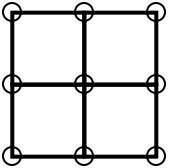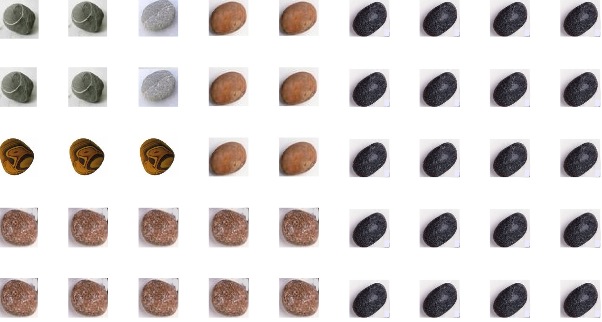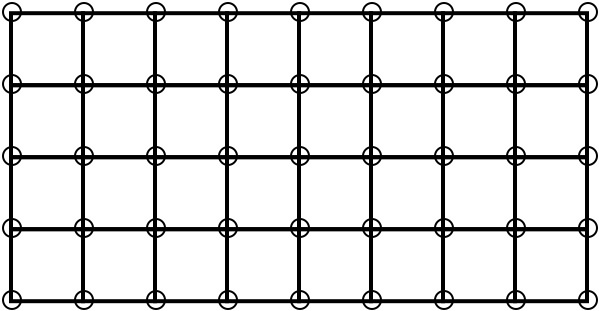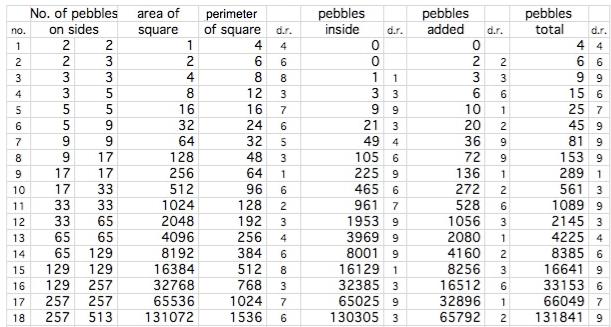Copyright © University of Cambridge. All rights reserved.
Pebbles
Imagine that you're walking along the beach, a rather nice sandy beach with just a few small pebbles in little groups here and there. You start off by collecting just four pebbles and you place them on the sand in the form of a square. The area inside is of course just $1$ square something, maybe $1$ square metre, $1$ square foot, $1$ square finger ... whatever.


By adding another $2$ pebbles in line you double the area to $2$, like this:


The rule that's developing is that you keep the pebbles that are down already (not moving them to any new positions) and add as FEW pebbles as necessary to DOUBLE the PREVIOUS area, using RECTANGLES ONLY!
So, to continue, we add another three pebbles to get an area of $4$:


You could have doubled the area by doing:


But this would not obey the rule that you must add as FEW pebbles as possible each time. So this one is not allowed.
Number 6 would look like this:


So remember:-
The rule is that you keep the pebbles that are down already (not moving them to any new positions) and add as FEW pebbles as necessary to DOUBLE the PREVIOUS area.
Well, now it's time for you to have a go.
"It's easy,'' I hear you say. Well, that's good. But what questions can we ask about the arrangements that we are getting?
We could make a start by saying "Stand back and look at the shapes you are getting. What do you see?'' I guess you may see quite a lot of different things.
It would be good for you to do some more of this pattern. See how far you can go. You may run out of pebbles, paper or whatever you may be using. (Multilink, pegboard, elastic bands with a nail board, etc.)
Well now, what about some questions to explore?
Here are some I've thought of that look interesting:
- How many extra pebbles are added each time? This starts off $2$, $3$, $6$ ...
- How many are there around the edges? This starts off $4$, $6$, $8$ ...
- How big is the area? This starts off $1$, $2$, $4$ ...
- How many are there inside? This starts off $0$, $0$, $1$, $3$, $9$ ...
Try to answer these, and any other questions you come up with, and perhaps put them in a kind of table/graph/spreadsheet etc.
Do let me see what you get - I'll be most interested.
Don't forget the all-important question to ask - "I wonder what would happen if I ...?''
Why do this problem?
Use this activity to introduce children to an investigation that mixes both shape and space work with number work. You could also introduce learners to this extended piece of work to help you look at perseverence and persistence.
Possible approach
A good introduction can be had with the whole class by making the first two or three arrangements all together. It is useful to have squared and dotted (squares) paper available whilst some pupils may benefit from using blocks (such as multilink) to represent the pebbles. You may also find it helpful to use a virtual geoboard for sharing ideas amongst the whole group.
After children have worked in pairs for a time, investigating subsequent arrangements, you can pose some of the suggested questions (for example looking at the number of pebbles added each time) and invite them to ask and explore their own questions. Encourage record keeping in whatever form the pupils feel is appropriate.
Key questions
What are you counting? (Sometimes there is confusion about the counting of the pebbles and the counting of the spaces in between them - particularly along the lengths of sides.)
Is this rectangle double the size of the last one?
How are you recording what you have done?
Possible extension
Some pupils may produce a table or a spreadsheet of their results which would enable them to explore further.
Here is an example of many results that lead to the consideration of the digital roots (d.r.):
Alternatively, Making Squares is an extension activity.
For more extension work
Go to More Pebbles.
Possible support
Children may benefit from adult support in keeping track of where they are in their exploration. They could be helped to proceed as if it were a game.










